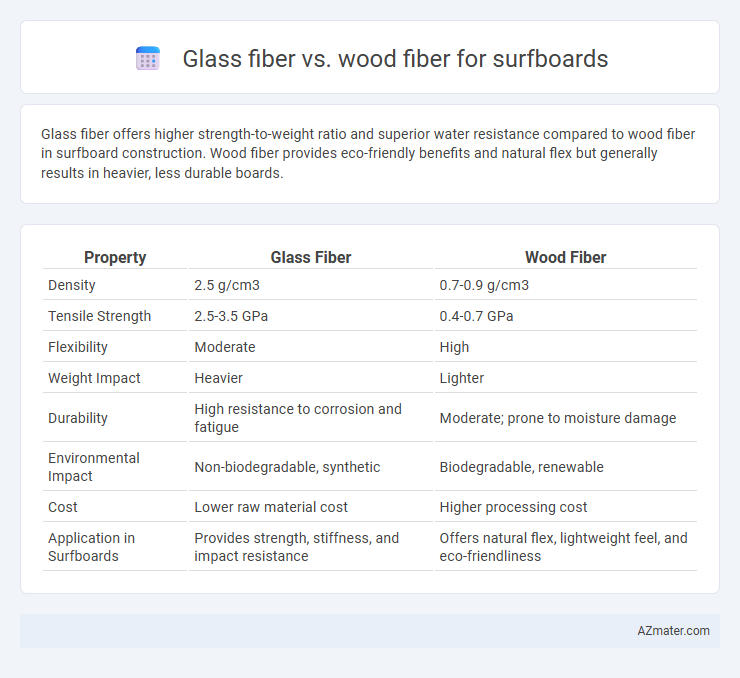Glass fiber offers higher strength-to-weight ratio and superior water resistance compared to wood fiber in surfboard construction. Wood fiber provides eco-friendly benefits and natural flex but generally results in heavier, less durable boards.
Table of Comparison
| Property | Glass Fiber | Wood Fiber |
|---|---|---|
| Density | 2.5 g/cm3 | 0.7-0.9 g/cm3 |
| Tensile Strength | 2.5-3.5 GPa | 0.4-0.7 GPa |
| Flexibility | Moderate | High |
| Weight Impact | Heavier | Lighter |
| Durability | High resistance to corrosion and fatigue | Moderate; prone to moisture damage |
| Environmental Impact | Non-biodegradable, synthetic | Biodegradable, renewable |
| Cost | Lower raw material cost | Higher processing cost |
| Application in Surfboards | Provides strength, stiffness, and impact resistance | Offers natural flex, lightweight feel, and eco-friendliness |
Introduction: Choosing the Right Surfboard Material
Glass fiber offers superior strength, durability, and waterproof properties essential for withstanding harsh marine conditions on surfboards. Wood fiber provides a natural, eco-friendly alternative with enhanced flexibility and lightweight characteristics that appeal to environmentally conscious surfers. Selecting between glass fiber and wood fiber depends on performance needs, sustainability goals, and desired board longevity.
Overview of Glass Fiber in Surfboard Construction
Glass fiber is a widely used material in surfboard construction due to its high strength-to-weight ratio and excellent durability. It provides superior resistance to impacts and flex, enhancing the overall performance and longevity of the surfboard. The layering of glass fiber cloth with polyester or epoxy resin creates a rigid, waterproof shell that protects the foam core while maintaining lightweight maneuverability.
Overview of Wood Fiber in Surfboard Construction
Wood fiber in surfboard construction offers a sustainable alternative known for its lightweight and flexible properties, enhancing board durability and performance in various wave conditions. This material provides excellent impact resistance and natural flex, improving the board's responsiveness and overall ride quality. Compared to traditional glass fiber, wood fiber reduces environmental impact while maintaining strength and resilience essential for high-performance surfboards.
Weight Comparison: Glass Fiber vs Wood Fiber
Wood fiber surfboards generally weigh less than those reinforced with glass fiber, offering enhanced buoyancy and ease of maneuverability. Glass fiber adds strength but increases overall board weight by approximately 15-30%, impacting paddling speed and agility. Choosing wood fiber can provide a lighter, more responsive surfboard ideal for performance-focused surfers.
Durability and Longevity Factors
Glass fiber offers superior durability for surfboards due to its high resistance to impact, water absorption, and UV damage, enhancing the board's longevity in harsh ocean conditions. Wood fiber, while providing natural flex and aesthetics, tends to absorb moisture and is more susceptible to delamination and rot, reducing its lifespan when exposed to continual water exposure. Surfboards reinforced with glass fiber maintain structural integrity over extended use, making them a preferred choice for long-term performance and durability.
Flexibility and Performance Differences
Glass fiber offers superior flexibility and durability for surfboards, allowing for a more responsive ride and enhanced maneuverability in various wave conditions. Wood fiber, while providing natural stiffness and eco-friendly properties, tends to result in less flex, which can limit performance in dynamic wave situations. The choice between glass fiber and wood fiber significantly impacts the surfboard's flex pattern and overall ride quality, influencing speed, control, and wave adaptability.
Environmental Impact and Sustainability
Glass fiber surfboards generate significant environmental impact due to the energy-intensive production and non-biodegradable nature of fiberglass materials, resulting in persistent landfill waste. Wood fiber surfboards offer enhanced sustainability by utilizing renewable, biodegradable resources, often sourced from responsibly managed forests or recycled wood, reducing carbon footprint and ecological harm. Selecting wood fiber composites fosters a more eco-friendly surfboard industry aligned with circular economy principles and reduced reliance on petroleum-based products.
Cost Analysis: Glass Fiber vs Wood Fiber
Glass fiber typically incurs higher initial costs due to material prices and specialized manufacturing processes, making it a more expensive choice for surfboard construction. Wood fiber, particularly from sustainably sourced materials like balsa or paulownia, offers a cost-effective alternative with competitive durability and weight advantages. When factoring in long-term maintenance and potential repairs, wood fiber surfboards often present better cost efficiency without compromising performance quality.
Aesthetics and Customization Options
Glass fiber offers a sleek, glossy finish that enhances the visual appeal of surfboards with vibrant, translucent colors and intricate patterns easily achieved through resin tinting and layering techniques. Wood fiber provides a natural, organic look with unique grain patterns, allowing for custom inlays and hand-carved designs, appealing to surfers seeking a vintage or artisanal aesthetic. Both materials offer distinct customization options, with glass fiber excelling in modern, high-contrast visuals and wood fiber delivering warm, earthy tones and texture variations.
Conclusion: Which Fiber is Best for Your Surfboard?
Glass fiber offers superior strength, durability, and water resistance, making it ideal for high-performance surfboards that demand longevity and speed. Wood fiber provides natural flexibility and environmental sustainability, appealing to surfers seeking eco-friendly, lightweight boards with unique aesthetics. The best choice depends on your priorities: choose glass fiber for robust performance and durability, or wood fiber for eco-conscious design and natural feel.

Infographic: Glass fiber vs Wood fiber for Surfboard
 azmater.com
azmater.com